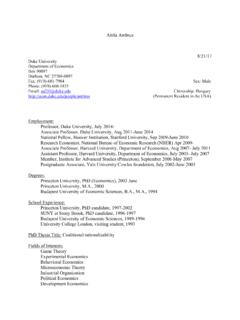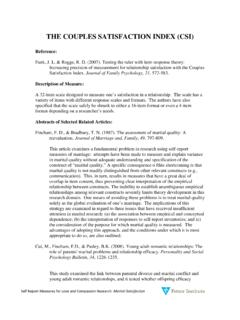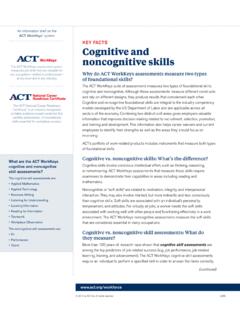Transcription of Triangulation: Establishing the Validity of
1 Publication is FCS6014, one of a series of the Department of Family, Youth and Community Sciences, Florida Cooperative Extension Service, Instituteof Food and Agricultural Sciences, University of Florida. Publication: September 2002. Reviewed by: Susanna Smith, , associate professor, HumanDevelopment, Department of Family, Youth and Community Sciences. Please visit the EDIS Web site at Institute of Food and Agricultural Sciences is an equal opportunity/affirmative action employer authorized to provide research,educational information and other services only to individuals and institutions that function without regard to race, color, sex, age, disability,or national origin. For information on obtaining other extension publications, contact your county Cooperative Extension Service Cooperative Extension Service / Institute of Food and Agricultural Sciences / University of Florida / Christine Taylor Waddill, A.
2 Guion, , assistant professor, Department of Family, Youth and Community Sciences, Cooperative Extension Service, Institute of Food andAgricultural Sciences, University of Florida, Gainesville, : Establishing the Validity ofQualitative Studies1 Lisa A. Guion2 Has anyone ever questioned whether yourevaluation results were true or credible? If so, then thevalidity of your evaluation study was questioned. Validity , in qualitative research, relates towhether the findings of your study are true andcertain. "True" in the sense of your findingsaccurately reflecting the real situation. "Certain" inthe sense of your findings being backed by evidence. Certain means that there are no good grounds fordoubting the results; the weight of evidencesupports your conclusions. Triangulation is a method used by qualitativeresearchers to check and establish Validity in theirstudies.
3 In this paper, five types of triangulation willbe examined: G data triangulation, G investigator triangulation,G theory triangulation, G methodological triangulation, andG environmental triangulation. After studying this paper, you should be able toapply basic methods of triangulation to yourqualitative evaluations. So, the next time you areasked to prove whether your qualitative evaluationfindings are correct, you will be able to describe howyou checked the Validity of your findings anddescribe why you have confidence in your TriangulationData triangulation involves the use of differentsources of data/information. A key strategy is tocategorize each group or type of stakeholder for theprogram that you are evaluating. Then, be certain toinclude a comparable number of people from eachstakeholder group in the evaluation study.
4 For example, suppose you are evaluating anafterschool program that you are overseeing. Youwould first identify the stakeholder groups such asyouth in the program, their parents, school teachers,school administrators, afterschool program staff andvolunteers. You decide to conduct in-depth interviews to gaininsight on what the stakeholders perceive as outcomesof the program. You would then interviewrepresentatives of each stakeholder group. You wouldtriangulate by looking for outcomes that are agreedupon by all stakeholder groups. The weight ofevidence suggests that if every stakeholder, who islooking at the issue from different points of view, seesan outcome then it is more than likely to be a trueoutcome. This type of triangulation is perhaps the mostpopular, easiest to implement, and is particularlyTriangulation: Establishing the Validity of Qualitative Studies Page 2 September 2002suited for Extension given the different stakeholdergroups that have vested interest in our programs.
5 Investigator TriangulationInvestigator triangulation involves using severaldifferent investigators/evaluators in an evaluationproject. Typically, this would manifest as anevaluation team that consists of your colleagueswithin your program area/field of study. In order totriangulate, each different evaluator would study theprogram using the same qualitative method(interview, observation, case study, or focus groups). The findings from each evaluator would becompared. If the findings from the differentevaluators arrive at the same conclusion, then validityhas been established. If the conclusions differsubstantially, then further study is warranted touncover the "true" and "certain" finding. For example, suppose you are conducting pre/postobservations of youth in the 4-H public speakingprogram to assess changes in nonverbalcommunication and public speaking skills.
6 In orderto triangulate, you would line up different colleaguesin your disciple/field to serve as evaluators. Eachperson would have the same observation check sheetfor pre- and post-observations. In the final analysis, Validity would be established for those same practicechanges and skills that were identified by eachdifferent observer (per child). While this is an effective method of establishingvalidity, it may not always be practical to assembledifferent investigators/evaluators given timeconstraints and individual TriangulationTheory triangulation involves the use of multipleprofessional perspectives to interpret a single set ofdata/information. Unlike investigator triangulation,this method typically entails using professionalsoutside of your field of study. One popular approach is bring together peoplefrom different disciplines, however, individualswithin disciplines are used if they are in differentstatus positions.
7 In theory it is believed thatindividuals from different disciplines or positionsbring different perspectives. Therefore if eachevaluator from the different disciplines interprets theinformation in the same way (draws the sameconclusions), then Validity is established. For example, suppose you are interviewingparticipants from your nutrition program to learn whatdiet or healthy lifestyle practice changes they attributeto participating in your program. To triangulate theinformation, you could then share the transcripts withcolleagues in different disciplines ( nutrition,nursing, pharmacy, public health education, etc.) tosee what their findings and conclusions are. Youwould compare those and again, as with othersmethods of triangulation, you would look forcongruence to establish validation in your findings. As with investigator triangulation, this methodmay not be feasible in all situations.
8 Also, it may bemore time consuming to try to involve individualsfrom other TriangulationMethodological triangulation involves the use ofmultiple qualitative and/or quantitative methods tostudy the program. If the conclusions from each of themethods are the same, then Validity is established. For example, suppose you are conducting a casestudy of one of your Welfare-to-Work participants todocument changes in her life as a result ofparticipating in your program over a one- year would not just use one method, but you woulduse interviewing, observation, document analysis, orany other feasible method to assess the changes. Youcould also survey the participant, her family membersand case workers (quantitative method). If thefindings from all of the methods draw the same orsimilar conclusions, then Validity in the finding hasbeen is also a popular method of triangulation thatis widely used.
9 However, in practice, this method mayrequire more resources in order to evaluate theprogram using different methods. Likewise, it willrequire more time to analyze the data/informationyielded by the different : Establishing the Validity of Qualitative Studies Page 3 September 2002 Environmental TriangulationThis type of triangulation involves the use ofdifferent locations, settings and other key factorsrelated to the environment in which the study tookplace, such as time of the day, day of the week orseason of the year. The key is identifying whichenvironmental factor, if any, may influence theinformation you received during the study. Theenvironmental factor is changed to see if the findingsare the same. If the findings remain the same undervarying environmental conditions, then Validity hasbeen established. For example, suppose you want to evaluate theeffectiveness of your money management program.
10 You want to determine if your program helpsparticipants develop budgets to minimize spendingand increase savings. If you evaluate during theholiday season, you may get different results becausespending is greatly increased during that time of order to triangulate, you would need to evaluate thebudgeting, spending and saving habits of yourparticipants throughout the year in order to gather trueand certain information on their behavior the other types of triangulation,environment triangulation cannot be used in everycase. It is only used when it is likely that the findingsmay be influenced by some environmental factor. ConclusionFive different ways to establish Validity for yourqualitative evaluations have been explored in thisarticle. After reading this article, yu should now beable to use one of these methods, whichever is mostfeasible and appropriate, to determine whether yourfindings are valid (true and certain).












